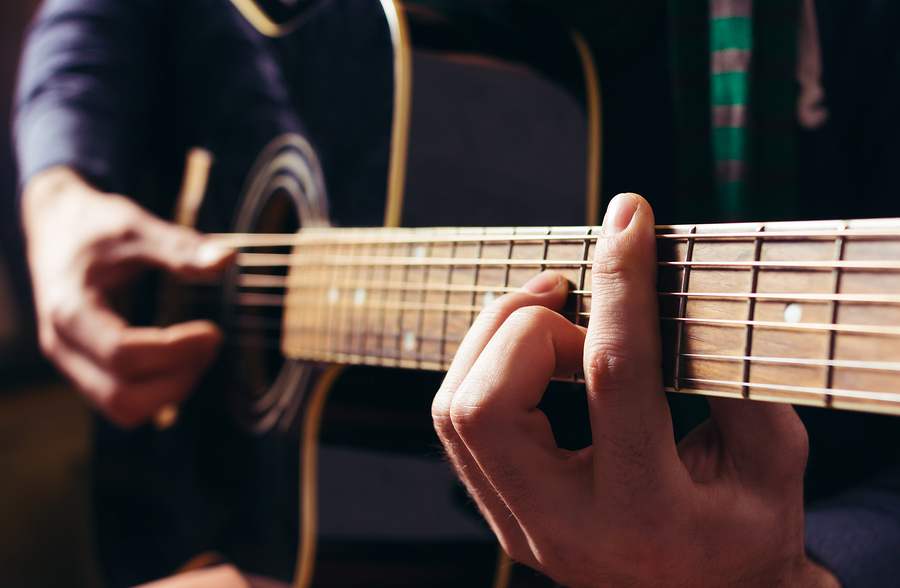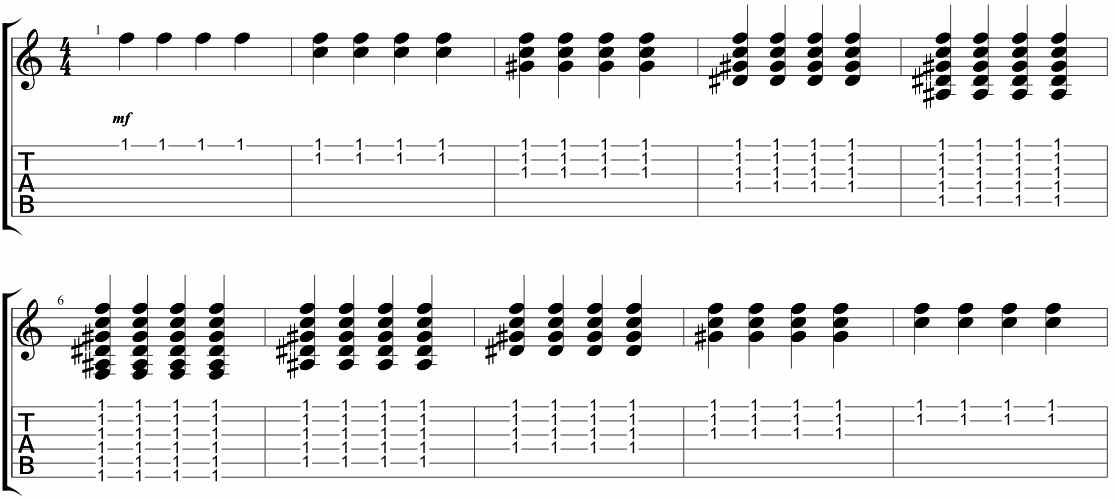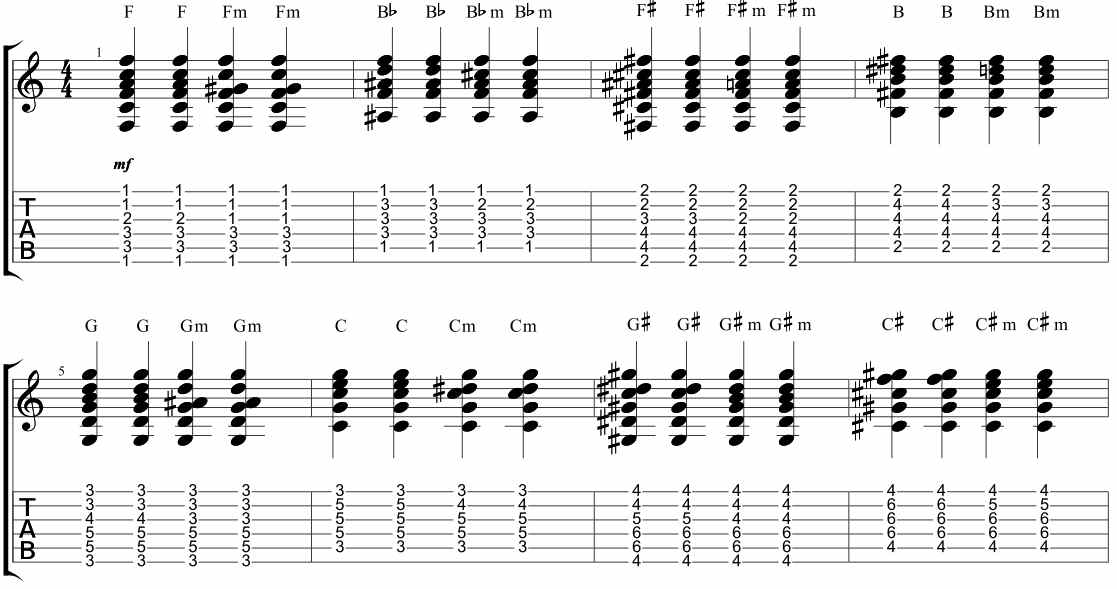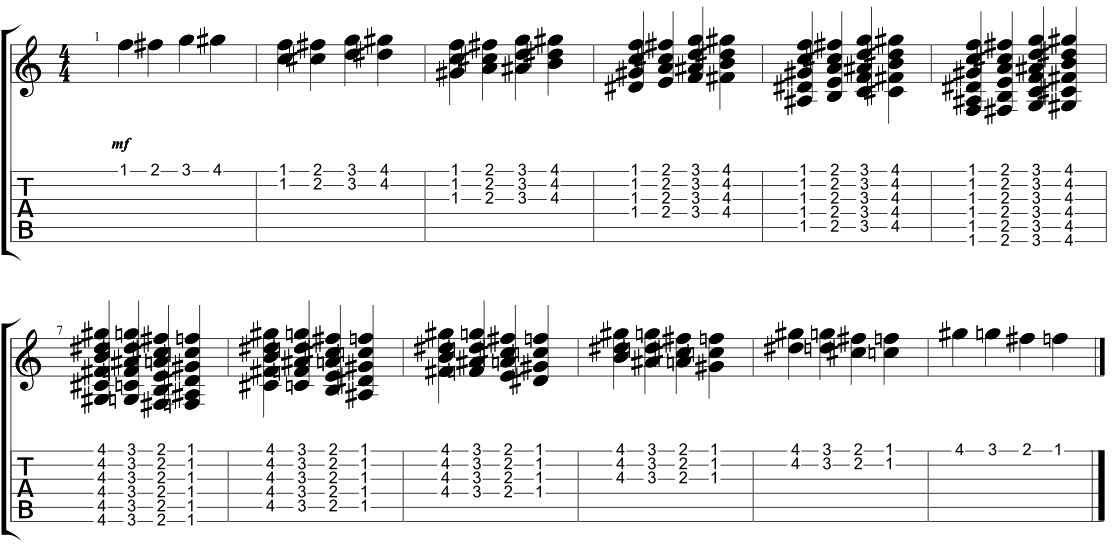May 14, 2019 by Klaus Crow
Bigstock photo
 Getting a barre chord to sound good is a real struggle for many guitar students, especially on an acoustic guitar.
Getting a barre chord to sound good is a real struggle for many guitar students, especially on an acoustic guitar.
It takes a while to really get a barre chord to sound clean and clear. Let’s be honest here, barres are nasty pain in the &ss and can be pretty frustrating at first.
It almost feels like impossible to apply the amount of pressure on the fingers to get them sound smooth.
But don’t worry, if you follow the tips and exercises in this post, it’s gonna get better, a lot better. If fact, you’re gonna do great!
The trick is not just about pressing hard. There’s more to it. Yes, it is important to press your index finger firmly down on the strings in order to make it work, but then again, you don’t want to push too hard either. You need to find the right balance. Whatever you do, do not strain! Don’t be a wimp, but if you’re feeling cramps just let go for a minute.
Watch the positioning of your fingers. Alter the positioning of your index finger slightly up or down to see if you can fix some of the buzzes and mutes. Try rolling it to the sight a bit. Make sure your thumb is right behind the neck to give it enough support. Observe all your fingers and hand position carefully.
Don’t expect your barres to sound great in the beginning, it’s part of the process. Your fingers need to build strength but also learn to shape the right way. It takes some time for your fingers to find the right placement onto the strings. So it’s not just a matter of strength but also technique and the latter takes practice and patience.
Make it a habit to practice every song with barre chords. Start by replacing an open chord for a barre chord. Once you feel comfortable gradually add more barres to the song and learn to switch from one barre chord to the next.
Another thing that can really help, and is not to be underestimated, is lowering the action on your guitar. A lot of guitars have poor or high action which makes it really hard for you to make your chords sound properly. Go to your local guitar shop and see if they can adjust the action of your guitar to improve the comfort and playability of the guitar. It can make all the difference.
Having taken all these things into account, it can be still a challenge. The exercises below are designed to build the strength you need in order to get them sound clean and clear. It’s the ultimate barre fitness workout for your fingers.
Practice the exercises below for 15 to 30 min a day to improve and speed up your barre progress so that you got this thing covered as quickly as possible.
Your effort will pay off!
BARRE EXERCISE #1
For the first exercise you only need to use your first (index) finger. In measure one, start on the first fret high e-string and play each note four times. In measure two, bar the first two strings (high e and b string) with your index finger. Strum both strings 4 times simultaneously. Press hard enough so that each note sounds clean and clear. In measure three, bar 3 strings (high e, b and g string) with your index finger and strum all three strings 4 times simultaneously and so on.
Once you played through the entire exercise (measure 1 to 10) you play the exact same exercise again but now starting on the second fret. Then play the exercise starting on the 3rd fret, 4th fret all the way up to the 12th fret and back again. This exercise is not about speed but about quality. Take your time, play slowly, keep focused and try to make all the notes sound as good as possible.
BARRE EXERCISE #2
In this exercise you work with the four essential barre chord shapes. Strum each bar chord two times and then move on the next chord (2 chords in a measure). Once you’ve played all four chords nice and clean you move on to the second fret and play the exact four chords again. Then move on to the 3rd fret, 4th fret all the way up to the 12th fret and back again.
As in exercise #1 it’s not about speed but about quality. Make sure each note of barre chords sounds as good as possible. In the beginning it’s hard and you might not get much sound at all, but as you practice and improve each day your chords gonna sound better and better within weeks. You’ll be capable of amazing things.
BARRE EXERCISE #3
This exercise is the most challenging one, but quite worth the effort. For the 1st fret you use your index finger, for the second fret use your middle finger, third fret ring finger and for the fourth fret use your pinky.
In measure two, you need to bar the first two strings (high e and b string) with your index finger, then use your middle finger on the second fret, your ring finger on the 3rd fret, and your pinky on the 4th fret. In measure three, bar 3 strings (high e, b and g), measure four bar four strings and so on.
When you’ve arrived at measure four, barring 4 strings with your pinky get’s tough and you might want to support it by sliding your ring finger on top of your pinky. How far you will get barring all the strings will also depend on how high the action is on your guitar. If your guitar has a lower action (meaning the strings are closer to the frets), it will be easier for you to bar the strings. Also barring strings on an electric guitar is easier than on an acoustic guitar. But practicing bar chords on your acoustic will definitely make your fingers stronger.
It’s not crucial to be able to bar all the strings with your pinky, not at all. It’s just an exercise that will develop and increase the strength in all your fingers. You can also play the first 3 measures all the way through, then skip your pinky in measure 6 to 9 and get your pinky back in the game in measure 10 to 12.
Once you played through the entire exercise start from scratch but instead of playing 1 2 3 4, now play the 2 3 4 5 and then play 3 4 5 6 all the way up to 9, 10, 11, 12 and then all the way back again. It takes time, but it’s rewarding.
After playing an exercise all the up to the 12th fret and back, take a break for 2 minutes. Massage your hands and fingers and relax.
Now try to play a bar chord and see how much better and lighter that feels than before the exercise.
Can you imagine the progress if you practice these exercises for 30 days in a row?



Hi Klaus sir,
I know that playing a barre chord is not easy. I also had many difficulties playing barre chords. It made me to struggle a lot. I am going to practice these exercises so that i will improve and speed up my progress.I hope that practicing these exercises and in time i may also
able to make the barre chords sound clean. Thanks for sharing.
Hi Prasana,
Just follow the tips and exercises and progress is on it’s way.
Best regards,
Klaus Crow
Your Gusto in this post cannot be overstated “Don’t be a whimp” haha. I have been learning some acoustic songs with the F chord recently. My hands are pretty strong and experienced so if I concentrate I can get all the strings to ring out no problem but occasionally it just misfires and sounds horrible, I don’t miss the chord but my index finger just doesn’t land right all the time. Thanks for these exercises I think adding some of them into my practice is going to do way more good then just playing the F chord over and over again.
The hardest spot on the neck to barre is fret 1. IMHO, starting barre practice there is sure to produce frustration in beginners. Try starting around frets 7-9. There is less tension on the strings there and the frets are spaced well enough apart to have plenty of room for your fingers to land. Build up proficiency there and move to either end of the neck as you improve.
Yes, that barre F E-type is the hardest, but it’s also the workhorse. Knowing CAGED helps with barre exercises, especially the E-, A-, and G-types. Bob Weir used the C-type a lot when comping. So obviously that just leaves the D-type, and it’s more of a fingered chord form. I remember playing damn barre chords for a couple years before getting the sound right.
Hi Klauss,
I did not understand one thing (or I’m not quite sure), is it supposed to bar 6 strings with the middle, ring and pinky finger ?
Hello
Thanks for your clear, and great instructions on these exercises!
I’m visually impaired, and can’t see images, I can read text with Screen-Reading software though, I kinda hate bloggers who use images to convey themselves.
Once again, thanks for your great site and articles. I’m an electric guitar beginner and I’m going to bookmark your site!
thanks
Great help. Yours most helpful I have found online!
this is Raghu ram …..
I have a lot of problem in changing the chords……
in fact I’m a beginner so any suggestions please….
These exercises are great. However, most classical guitar pieces have barre chords in-between other notes. So, you need to QUICKLY lay down your barre and get it right the first time. And this is where I have my problems–especially with the B major chord while barring the second fret. I’m looking for exercises that do this. With the B major chord, I’m almost tempted to jump up to the 7th fret and play an E major fingering because it’s easier, and I can land it quicker. I use many of the Sor etudes to practice, but B major both with a barre and without are my true downfall. Any suggestions or exercises would be appreciated.